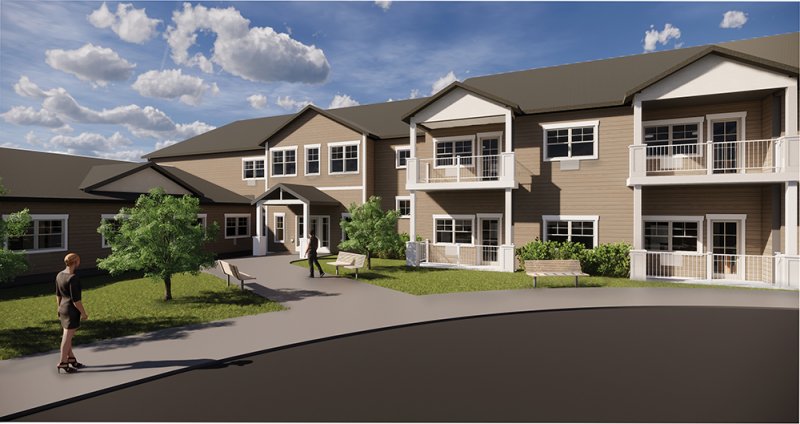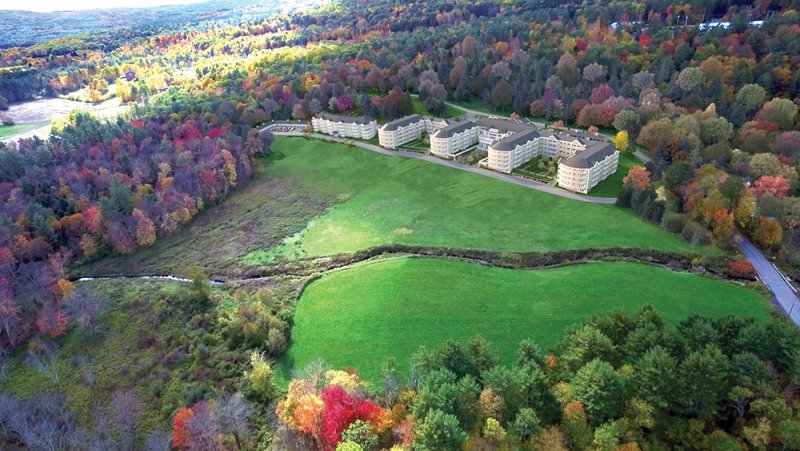
Taylor Community residents enjoy Pub Night in the Oasis the first Friday night of every month. Here they celebrate Cinco de Mayo. Courtesy photo.
Nestled on 104 acres of woods off Union Avenue in Laconia, Taylor Community on a Friday night might catch the ears of passers by with the sound of unexpected shenanigans.
“We started a new pub night,” says Michael Flaherty, president and CEO, adding that the three-hour weekly event is one of the most popular activities on campus, typically drawing 75 residents. “The desire to have social contact with alcohol doesn’t end when you leave college.”
As such, Flaherty says the nonprofit continuing care retirement community (CCRC) has big plans not only to expand living spaces on campus, but add amenities to liven things up for residents. He says they are in the process of securing permits to construct an outdoor courtyard complete with a kitchen, walking track, shuffleboard, putting green and fireplace.
“What we think of as a retirement community is not what it was 20 years ago,” Flaherty says. “It’s not about what does grandma want? It’s what would you want? And then putting those things in there because that’s what they want to use. [Residents] don’t see themselves as old people. They just see themselves as people who’ve maybe slowed down a little bit, but still need social interaction.”
Heavy Demand
Competition within the retirement sector continues to rise as more demanding boomers reach retirement. According to Ibisworld.com, market research shows that over the past five years, the retirement community industry has grown by 3.6 percent in the U.S., reaching revenues of $69 billion in 2018. Over that same period, the number of businesses in the retirement community industry has grown by 2 percent and the number of employees has grown by 3.8 percent.
While employment growth in this sector is actually projected to dip 1 percent in 2019, employment at NH’s nursing and residential facilities is projected to grow by 13 percent by 2026. This industry expansion is due in large part to the sheer number of baby boomers aging into assisted living as well as living longer and needing memory care, says Justine Vogel, president and CEO of The RiverWoods Group, the parent company of CCRCs in Exeter, Manchester and soon Durham. “I’m sure you’ve seen the statistic that there are 10,000 people a day turning 72,” Vogel says. “So definitely the industry or the sector is being driven by demographics.”
Bret Pomeroy, administrator at Warde Health Center in Windham, which is part of Catholic Charities NH, points out that NH has one of the oldest populations in the country. “On the assisted living side, the aging population for that level of care is projected to increase 50 percent by 2025,” he says. “That’s why you see a lot of construction for assisted living.”
Demand for skilled nursing facilities is also high, with occupancy rates averaging about 92 percent, Pomeroy says, which is expected to increase.
Major Expansions
In October, Warde Health Center broke ground on a 38,000-square-foot independent living facility on its campus.
Warde Independent Living will sit on the former site of Castle Junior College and will be connected to Warde Rehabilitation and Nursing Center. The building includes a new two-story wing with 21 independent senior living units with an adjacent carport. The facility will also include a single-story wing with 10 assisted living units.

A rendering of the new 38,000-square-foot independent living community on the Warde Health Center campus in Windham, slated to open in Summer 2019. Courtesy photo.
The expansion will bring the total size of the Center to 59,000 square feet, which includes the existing 68 private rooms for short-term rehabilitation, long-term care and assisted living at Warde Rehabilitation and Nursing Center.
The project is expected to be completed in fall 2019, Pomeroy says. “We currently operate three other independent living units, and those are pretty much 100 percent full, 99 percent of the time,” he says.
RiverWoods has responded to these trends by creating an affiliation and expanding its capacity, Vogel says. In 2016, Birch Hill, a CCRC in Manchester, affiliated itself with RiverWoods to better compete with for-profit providers. “It’s really hard to be a stand-alone player in the marketplace today” because of how complex the health care environment can be, Vogel says. RiverWoods is also developing and constructing a community called RiverWoods Durham near the University of NH. Its 150 units sold out in 28 days, Vogel says, and it has 75 people on a wait list.
Flaherty says Taylor is also expanding and its plans include possibly building a new assisted living facility to replace the original Taylor facility, raising the number of available units from 67 to 107 and adding memory care units. It also has plans to build another neighborhood on the Laconia campus, which would add six independent living cottages to its existing 123 cottages and 57 independent living units.
“You don’t want to overbuild,” he says. “We’ll be renovating our current Taylor home once we build the new assisted living in the next 12 to 18 months.” The existing facility will become independent living, with between 12 to 20 apartments. “That’s probably the extent of the growth of our Laconia campus,” he says.
Taylor is also looking into possible expansions in Wolfeboro and may be in the market for adding a third location in the future, Flaherty says.
Moreover, new players, such as Hillside Village in Keene, are coming into the market. Jolynn Whitten, executive director, says phase one of this new facility will open this month. It will include more than 220 units, including 140 independent living, 43 assisted living, 18 memory support and 20 nursing care.

Hillside Village in Keene. Courtesy photo.
It’s About the Amenities
In such a crowded market, one thing that can keep these facilities competitive are the amenities they can offer.
Whitten says Hillside is outfitted with a performing arts center, which she says was “important to our prospects since this area is so rich in the arts.”
“Also, a robust wellness program is key, hence the fitness center, group exercise room and indoor pool,” she says.
“We will also have a variety of dining venues to suit every palate.”
RiverWoods and Taylor’s facilities also reflect that desire by community residents for good food and access to opportunities to improve their well-being. Vogel says RiverWoods developed an “optimal health and wellness” approach designed to meet the needs of individual residents. “How does one person define their optimum health and wellness?” she says. “For one person, it might be more about volunteering or continuing learning or getting into the arts. For another person it might be more about really good farm-to-table eating and working on their physical fitness.”

Resident Sally Hollaman reads to students in a library at RiverWoods. Courtesy photo.
Likewise, Flaherty says Taylor invested in making sure seniors in its community have ample opportunities to feed their social well-being. He says it not only hired a wellness director, but also a resident life director. “She’s like Julie [McCoy, cruise director] on The Love Boat,” he says. “She’s always got things going on for them.”

Taylor residents participate in Tai Chi on the front lawn. Courtesy photo.
Those activities include overnight trips to New York, Vermont, the Berkshires and Cape Cod. Taylor started a mountain climbing club where at least eight residents climbed the mountains in the Belknap County Range. It even started a ski club and holds summer concerts with New York City musicians who vacation in the Lakes Region. “They try out a lot of their new material here,” Flaherty says. “[Amenities are] not the only thing, but [they’re] certainly a big component in how we’re staying competitive.”
Saturation Point?
With all this development and competition, could NH be nearing a market saturation point? The experts on this are of a mixed mind. Alain Bernard, assistant vice president of health care services for Catholic Charities NH, says he doesn’t feel the NH market has reached saturation by any means, primarily because the elderly population continues to significantly increase—a trend that’s expected at least through 2024.
Pomeroy echoes his colleague. “From what I’ve seen, I’m confident the demand and growth of the senior housing market will continue to expand,” he says. “The largest influx is likely ahead of us and many organizations are taking that into account, expanding to capitalize on this future growth. The recent increase in construction of new assisted living units across New Hampshire speaks to that trend.”
Cathleen Toomey, vice president of marketing for RiverWoods Group, says that while there has been tremendous growth in stand-alone for-profit assisted living and memory care facilities, with more projected, there is less market penetration by CCRCs like RiverWoods.
“I think you will see an increase in mixed-use development that mixes age-restricted housing with typical housing and retail and shopping environments, which provides flexibility,” Toomey says.
Others are a bit more cautious about the future. Whitten says it depends on the market, but in NH, there is still plenty of opportunity for growth. “17.6 percent of the population of New Hampshire is 65-plus, but there are only 13 licensed continuing care retirement communities,” she says. “The market has been growing in recent years to give older people more options for their care. This growth does have to be closely monitored to ensure that saturation doesn’t occur.”
Flaherty also says he’s concerned that if this situation is not monitored, overbuilding these communities will lead to trouble when this demographic bubble eventually bursts. “This is not a permanent trend,” he says. “It falls off a cliff in 20 years. So if we overbuild, we’re going to have a problem in 20 years. What are you going to do with all of these communities?”
There are some other factors in the mix that could dull the buzz of this boom. For one thing, this industry is not immune to nursing and provider shortages the country is experiencing. Pomeroy at Warde says there are statewide shortages in the skilled nursing sector, particularly with licensed positions such as licensed nursing assistants (LNAs), licensed practical nurses (LPNs) and registered nurses (RNs).
“I don’t envision it stalling the market, though. It will just make a more competitive market for hiring these necessary staff members,” he says.
Whitten at Hillside is less optimistic. “CCRCs have health centers with a continuum of care—assisted living, memory support and nursing care neighborhoods,” she says. “All of these levels of care require caregiving staff on a 24/7 basis. The shortages of LNAs, LPNs and RNs affects us just like all other health care providers.
“We have to find ways to educate the population, especially young people, about the career opportunities in retirement living,” she says. “We employ in many areas: nursing, maintenance, housekeeping, transportation, security, culinary, administrative and many more. With the extremely low unemployment rate, all of these positions are getting harder to fill. We need to be very creative with recruiting, onboarding and recognition efforts.”
Toomey agrees, saying the dearth of nursing employees in particular is a challenge and will continue to be so into the future given the state of the workforce, which is not keeping pace with the growth of older adults.
She says RiverWoods has been actively recruiting in the community, talking about job opportunities and career ladders, and inviting students to participate in internships and mentoring programs to see the variety of careers available in this sector. “In the end, we are a person-centered community and our staff is the linchpin of that promise, so we will always seek those who are looking to make a difference while making a living.”

 Current Issue - May 2024
Current Issue - May 2024